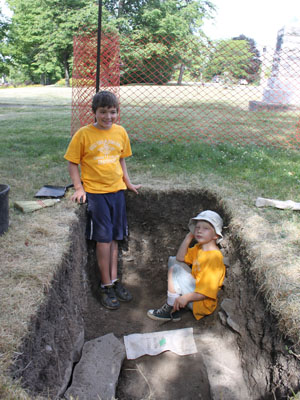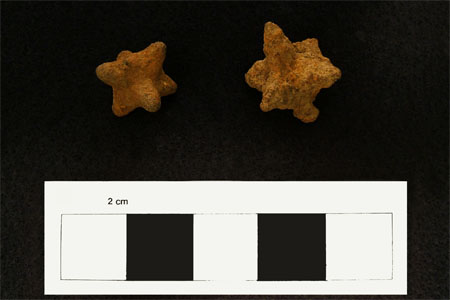 This year the“Can You Dig It?”© Summer Archaeology Program returned once again to the Warden’s Residence at Canada’s Penitentiary Museum. The Provincial Penitentiary of Upper Canada was constructed in 1833. Various extensive settlement and construction projects were carried out in the immediate area. Cedarhedge, the Kingston Penitentiary Warden’s residence, was completed in 1873 and it is this building that now houses Canada’s Penitentiary Museum.
This year the“Can You Dig It?”© Summer Archaeology Program returned once again to the Warden’s Residence at Canada’s Penitentiary Museum. The Provincial Penitentiary of Upper Canada was constructed in 1833. Various extensive settlement and construction projects were carried out in the immediate area. Cedarhedge, the Kingston Penitentiary Warden’s residence, was completed in 1873 and it is this building that now houses Canada’s Penitentiary Museum.
With the help of 39 participants, this archaeological season re-opened 3 units from the 2010 excavation, as well as opening new units. Unearthed in 2010 was a limestone drain that would have served the double-stone cottage built in 1833 for the Master Builder and Superintendent of Kingston Penitentiary, which housed them and their families during the construction of the Kingston Penitentiary. The two units in which the drain was discovered showed that it continued north and south from both units, seemingly in a straight line. And so in 2011, two more units were excavated on the south side to see where the drain ended. While our southernmost unit showed the drain curving westward, a very important find, the other new unit found no drain intact, and very little evidence of a drain. This unit, which lines up between the 2010 units and the other 2011 unit, is found to be beneath the location of the old driveway of Cedarhedge, now Canada’s Penitentiary Museum. We believe that that section was demolished with the creation or destruction of Cedarhedge’s original driveway. This is a perfect example of how not finding what you expected can give you new questions to ask, and new units to dig.
 Many interesting artifacts were recovered by the 2011 participants. Two pieces of a Jacks game were found during the upper-year week, which match the piece found by the 2010 “Can You Dig It?”© Summer Archaeology Program. We also found a bone handle, presumably from a knife, with the name “James” engraved on the side. Other artifacts found include pieces of clay pipes from Quebec and Scotland, as well as various ceramics.
Many interesting artifacts were recovered by the 2011 participants. Two pieces of a Jacks game were found during the upper-year week, which match the piece found by the 2010 “Can You Dig It?”© Summer Archaeology Program. We also found a bone handle, presumably from a knife, with the name “James” engraved on the side. Other artifacts found include pieces of clay pipes from Quebec and Scotland, as well as various ceramics.

 This year the“Can You Dig It?”© Summer Archaeology Program returned once again to the Warden’s Residence at Canada’s Penitentiary Museum. The Provincial Penitentiary of Upper Canada was constructed in 1833. Various extensive settlement and construction projects were carried out in the immediate area. Cedarhedge, the Kingston Penitentiary Warden’s residence, was completed in 1873 and it is this building that now houses Canada’s Penitentiary Museum.
This year the“Can You Dig It?”© Summer Archaeology Program returned once again to the Warden’s Residence at Canada’s Penitentiary Museum. The Provincial Penitentiary of Upper Canada was constructed in 1833. Various extensive settlement and construction projects were carried out in the immediate area. Cedarhedge, the Kingston Penitentiary Warden’s residence, was completed in 1873 and it is this building that now houses Canada’s Penitentiary Museum. Many interesting artifacts were recovered by the 2011 participants. Two pieces of a Jacks game were found during the upper-year week, which match the piece found by the 2010 “Can You Dig It?”© Summer Archaeology Program. We also found a bone handle, presumably from a knife, with the name “James” engraved on the side. Other artifacts found include pieces of clay pipes from Quebec and Scotland, as well as various ceramics.
Many interesting artifacts were recovered by the 2011 participants. Two pieces of a Jacks game were found during the upper-year week, which match the piece found by the 2010 “Can You Dig It?”© Summer Archaeology Program. We also found a bone handle, presumably from a knife, with the name “James” engraved on the side. Other artifacts found include pieces of clay pipes from Quebec and Scotland, as well as various ceramics.